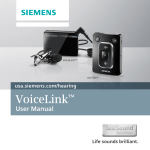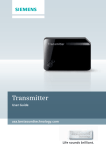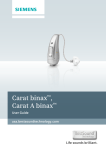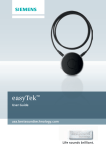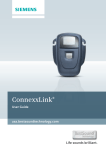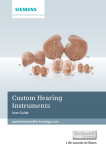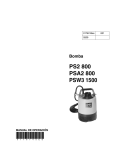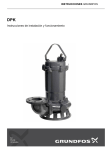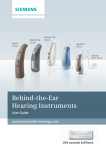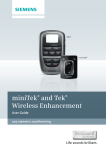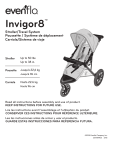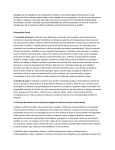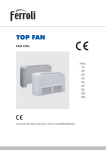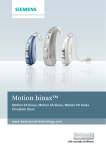Download Orion™ 2 RIC10
Transcript
Orion 2 RIC10 ™ User Guide usa.bestsoundtechnology.com Life sounds brilliant. Welcome Enhance your Siemens experience. Learn about your hearing aids and accessories you may find helpful, access the latest information about hearing health, and receive promotional offers by joining the Siemens hearing health community at* usa.bestsoundtechnology.com/join or: Learn more about Siemens products by scanning the QR code *We respect your privacy. We will not sell, rent, or give your name or e-mail address to anyone. At any time, you can select a link at the bottom of every email to unsubscribe or update profile. Thank you for choosing our hearing instruments to accompany you through everyday life. Like anything new, it may take you a little time to become familiar with them. This guide, along with support from your Hearing Care Professional, will help you understand the advantages and greater quality of life your hearing instruments offer. To receive the most benefit from your hearing instruments, it is recommended that you wear them every day, all day. This will help you get adjusted to them. CAUTION It is important to read this user guide and the safety manual thoroughly and completely. Follow the safety information to avoid damage or injury. Content Welcome 1 Your hearing instruments Instrument type Getting to know your hearing instruments Components and names Controls Settings 4 4 4 5 7 8 Batteries Battery size and handling tips Replacing batteries Further information Safety information Accessories Troubleshooting Service information 22 22 22 22 24 9 9 10 Daily use 12 Turning on and off 12 Inserting and removing the hearing instruments 13 Adjusting the volume 16 Changing the hearing program 16 Special listening situations On the phone 17 17 Maintenance and care Hearing instruments Ear pieces Professional maintenance 18 18 19 21 Symbols used in this document Points out a situation that could lead to serious, moderate, or minor injuries. Indicates possible property damage. Advice and tips on how to handle your device better. 2 3 Your hearing instruments This user guide describes optional features that your hearing instruments may or may not have. Ask your Hearing Care Professional to indicate the features that are valid for your hearing instruments. Instrument type Your hearing instruments are a RIC (Receiver-in-Canal) model. The receiver is placed within the ear canal and connected to the instrument via a receiver cable. The instruments are not intended for infants, small children or mentally disabled persons. Getting to know your hearing instruments It is recommended to familiarize yourself with your new hearing instruments. With the instruments in your hand try using the controls and note their location on the instrument. This will make it easier for you to feel and press the controls while wearing the hearing instruments. Components and names ૢ ૠ ૣ ૡ ➊Ear piece ➏Battery compartment ➋Receiver ➐Side indicator (red = right ear, blue = left ear) ➌Receiver cable ➍Microphone openings ➎Push button (optional) 4 ➑Receiver connection 5 Controls You can use standard or custom-made ear pieces. Standard ear pieces Size Click Dome single (open or closed) Click Dome semi‑open Click Dome double With the controls you can, for example, switch hearing programs. Your hearing instruments either have a push button or no control. Your Hearing Care Professional has programmed your desired functions to the push button. Control Left Right Push button You can easily exchange the standard ear pieces. Read more in section "Maintenance and care". No control Custom-made ear pieces Custom shell Click Mold You can use a smartphone app for remote control. Push button function L R Press <1 second: Program change Press >3 seconds: Standby/turn on L = Left, R = Right 6 7 Batteries Settings When the battery is low the sound becomes weaker or you will hear an alert signal. The battery type will determine how long you have to replace the battery. Hearing programs 1 Battery size and handling tips 2 Ask your Hearing Care Professional for recommended batteries. 3 4 Read more in section "Changing the hearing program". Battery size: 10 ■ Always use the correct battery size for your hearing Features Power-on delay enables whistle-free insertion of hearing instruments. Read more in section "Turning on and off". The tinnitus therapy feature generates a soft noise to distract you from your tinnitus. instruments. ■ Remove the batteries if you intend not to use the hearing instruments for several days. ■ Always carry spare batteries. ■ Remove empty batteries immediately and follow your local recycling rules for battery disposal. 8 9 Replacing batteries Removing the battery: XOpen the battery compartment. Inserting the battery: XIf the battery has a protective film, remove it only when you are ready to use the battery. XInsert the battery with the "+" symbol facing up (refer to the picture). XUse the magnet stick to pull out the battery. The magnet stick is available as an accessory. XCarefully close the battery compartment. If you feel resistance, the battery is not inserted correctly. Do not attempt to close the battery compartment by force. It can be damaged. 10 11 Daily use Turning on and off Inserting and removing the hearing instruments You have the following options to turn your hearing instruments on or off. Your hearing instruments have been fine-tuned for your right and left ear. Colored markers indicate the side: Via battery compartment: XTurning on: Close the battery compartment. The default volume and hearing program are set. XTurning off: Open the battery compartment to the first catch. ■ red marker = right ear ■ blue marker = left ear Inserting a hearing instrument: XHold the receiver cable at the bend closer to the ear piece. Via push button: XTurning on or off: Press and hold the push button for several seconds. Refer to section "Controls" for the settings of your controls. After turning on, the previously used volume and hearing program remain set. When wearing the hearing instruments, an alert tone can indicate when an instrument is being turned on or off. When the power-on delay is activated, the hearing instruments turn on after a delay of several seconds. During this time you can insert the hearing instruments into your ears without experiencing unpleasant feedback whistling. The "power-on delay" can be activated by your Hearing Care Professional. XCarefully push the ear piece in the ear canal ➊. XTwist it slightly until it sits well. Open and close your mouth to avoid accumulation of air in the ear canal. XLift the hearing instrument and slide it over the top of your ear ➋. CAUTION Risk of injury! XInsert the ear piece carefully and not too deeply into the ear. 12 13 ■ It may be helpful to insert the right hearing instrument with the right hand and the left hearing instrument with the left hand. ■ If you have problems inserting the ear piece, use the other hand to gently pull your earlobe downwards. This opens the ear canal and eases insertion of the ear piece. The optional retention strand helps to securely retain the ear piece in your ear. To position the retention strand: XBend the retention strand and position it carefully into the bottom of the bowl of your ear (refer to the picture). Removing a hearing instrument: XLift the hearing instrument and slide it over the top of your ear ➊. XIf your hearing instrument is equipped with a custom shell or a Click Mold, remove it by pulling the small removal cord toward the back of your head. XFor all other ear pieces: Grip the receiver in the ear canal with two fingers and pull it carefully out ➋. Do not pull the receiver cable. CAUTION Risk of injury! XIn very rare cases the ear piece could remain in your ear when removing the hearing instrument. If this happens, have the ear piece removed by a medical professional. Clean and dry your hearing instruments after usage. Read more in section "Maintenance and care". 14 15 Special listening situations Adjusting the volume On the phone Your hearing instruments automatically adjust the volume to the listening situation. When you are on the phone, hold the telephone receiver slightly above your ear. The hearing instrument and telephone receiver have to be aligned. Turn the receiver slightly so that the ear is not completely covered. You can use a smartphone app for volume control. Changing the hearing program Depending on the listening situation, your hearing instruments automatically adjust their sound. Your hearing instruments may also have several hearing programs which allow you to change the sound, if needed. An optional signal tone can indicate the program change. XTo change the hearing program, press the push button briefly. Telephone program You may prefer a certain volume when using the phone. Ask your Hearing Care Professional to configure a telephone program. XSwitch to the telephone program whenever you are on the phone. If a telephone program is configured for your hearing instruments, it is listed in section "Settings". Refer to section "Controls" for the setting of your controls. Refer to section "Settings" for a list of your hearing programs. 16 17 Maintenance and care To prevent damage it is important that you take care of your hearing instruments and follow a few basic rules, which will soon become a part of your daily routine. Hearing instruments Drying and storage XDry your hearing instruments overnight. XAsk your Hearing Care Professional for recommended drying products. XFor longer periods of non-use, store your hearing instruments with open battery compartment and batteries removed in a drying system to avoid the adverse effects of moisture. Cleaning Your hearing instruments have a protective coating. However, if not cleaned regularly you may damage the hearing instruments or cause personal injury. XClean your hearing instruments daily with a soft, dry Ear pieces Cleaning Cerumen (ear wax) may accumulate on the ear pieces. This may affect sound quality. Clean the ear pieces daily. For all types of ear pieces: XClean the ear piece right after removal with a soft and dry tissue. This prevents that cerumen becomes dry and hard. For Click Domes: XSqueeze the tip of the dome. tissue. XNever use running water or immerse the devices in water. XNever apply pressure while cleaning. XAsk your Hearing Care Professional for recommended cleaning products, special care sets, or more information on how to keep your hearing instruments in good condition. 18 19 Professional maintenance Exchanging Exchange standard ear pieces approximately every three months. Replace them sooner if you notice cracks or other changes. The procedure for exchanging standard ear pieces depends on the type of ear piece. In section "Components and names", your Hearing Care Professional has marked your type of ear piece. Exchanging Click Domes If you have problems removing the old Click Dome, use the removal tool or follow the instructions on the packaging of the Click Domes: Your Hearing Care Professional can perform a thorough professional cleaning and maintenance. Custom-made ear pieces and wax filters should be exchanged as needed by a professional. Ask you Hearing Care Professional for your individual recommendation of maintenance intervals and for support. The removal tool is available as an accessory. XTake particular care that the new Click Dome clicks noticeable in place. click 20 21 Further information Safety information For more safety information, refer to the safety manual supplied with the device. Problem and possible solutions Hearing instrument does not work. ■ Turn the hearing instrument on. ■ Gently close the battery compartment completely. Accessories You can use a smartphone app for remote control. Consult your Hearing Care Professional for further information. ■ Replace the empty battery. ■ Make sure the battery is inserted correctly. ■ Power-on delay is active. Wait several seconds and check again. Consult your Hearing Care Professional if you encounter further problems. Troubleshooting Problem and possible solutions Sound is weak. ■ Replace the empty battery. ■ Clean or exchange the ear piece. Hearing instrument emits whistling sounds. ■ Reinsert the ear piece until it fits securely. ■ Clean or exchange the ear piece. Sound is distorted. ■ Replace the empty battery. ■ Clean or exchange the ear piece. Hearing instrument emits signal tones. ■ Replace the empty battery. 22 23 Service information Serial numbers Left: Right: Service dates 1: 2: 3: 4: 5: 6: Your Hearing Care Professional Date of purchase: 24 Orion 2 RIC10 ™ Guía del usuario usa.bestsoundtechnology.com Life sounds brilliant. Bienvenido Mejore su experiencia Siemens. Aprenda acerca de los instrumentos auditivos y de los accesorios que le podrían ser útiles, acceda a la información más reciente sobre salud auditiva y reciba ofertas promocionales al formar parte de la comunidad de salud auditiva de Siemens en* usa.bestsoundtechnology.com/join o: Para conocer más acerca de los productos de Siemens escanee el código QR. *Respetamos su privacidad. No venderemos, alquilaremos ni daremos su nombre o dirección de correo electrónico a nadie. Para cancelar su suscripción o actualizar sus datos, en cualquier momento puede seleccionar el enlace que aparece en la parte inferior del correo electrónico. Gracias por seleccionar nuestros instrumentos auditivos Siemens para que le acompañen durante su vida diaria. Como con cualquier artículo nuevo, es posible que le tome un poco de tiempo familiarizarse con ellos. Esta guía, junto con el apoyo de su profesional de cuidado auditivo, le ayudará a entender las ventajas y la mejor calidad de vida que ofrecen sus instrumentos auditivos. Para recibir un mayor beneficio de sus instrumentos auditivos, se recomienda que los use cada día, durante todo el día. Esto le ayudará a adaptarse a ellos. PRECAUCIÓN Es importante leer atentamente esta guía del usuario y el manual de seguridad. Siga la información de seguridad para evitar daños o lesiones. Contenido Bienvenido 1 Sus instrumentos auditivos Tipo de instrumento Conociendo sus instrumentos auditivos Componentes y sus nombres Controles Configuración 4 4 4 5 7 8 Baterías Tamaño de la batería y sugerencias para su manipulación Reemplazo de las baterías 9 Información adicional Información de seguridad Accesorios Solución de problemas Información de servicio 22 22 22 22 24 9 10 Uso diario Encendido y apagado Colocación y extracción del instrumento auditivo Ajustar el volumen Cambio de programa auditivo 12 12 Situaciones especiales de audición Para hablar por teléfono 17 17 Cuidado y mantenimiento Instrumentos auditivos Auriculares Mantenimiento profesional 18 18 19 21 13 16 16 Símbolos utilizados en este documento Indica que la situación podría ocasionar lesiones graves, moderadas o leves. Indica un posible daño a la propiedad. Consejos sobre cómo manejar mejor su dispositivo. 2 3 Sus instrumentos auditivos Esta guía del usuario describe las funciones opcionales que pueden o no tener sus instrumentos auditivos. Pida a su profesional de cuidado auditivo que le indique cuáles de estas funciones son válidas para sus instrumentos auditivos. Componentes y sus nombres ૠ Tipo de instrumento Sus instrumentos auditivos son del modelo RIC (Receptor en el Canal). El receptor se coloca dentro del canal auditivo y se conecta al instrumento por medio de un cable receptor. Los instrumentos no están diseñados para uso en los bebés, los niños pequeños ni las personas con discapacidades mentales. Conociendo sus instrumentos auditivos Se recomienda que se familiarice con sus nuevos instrumentos auditivos. Con los instrumentos en la mano, trate de usar los controles y conozca su ubicación en el instrumento. Esto hará que le sea más fácil sentir y presionar los controles mientras usa los instrumentos auditivos. ૢ ૣ ૡ ➊Auricular ➏Compartimiento de la batería ➋Receptor ➐Indicador lateral ➌Cable del receptor ➍Aberturas del micrófono ➎Botón de presión (rojo = oreja derecha, azul = oreja izquierda) ➑Conexión del receptor (opcional) 4 5 Usted puede usar auriculares estándar o personalizados. Auriculares estándar Tamaño Click Dome único (abierto o cerrado) Click Dome semiabierto Controles Con los controles puede, por ejemplo, cambiar los programas de audición. Sus instrumentos auditivos tienen un botón de presión o no tienen control. Su profesional de cuidado auditivo programó sus funciones deseadas para el botón de presión. Control Click Dome doble Izquierdo Derecho Pulsador Puede cambiar fácilmente los auriculares estándar. Lea más en la sección "Mantenimiento y cuidado". Sin control Auriculares hechos a la medida Cubierta hecha a la medida Molde Click Puede usar una aplicación de teléfono inteligente como control remoto. Función Pulsador I D Presione < 1 segundo: Cambio de programa Presione > 3 segundos: En espera/Encendido I = Izquierdo, D = Derecho 6 7 Baterías Configuración Cuando la batería está baja, el sonido se debilita o se escucha una señal de alerta. El tipo de batería determina el tiempo que tiene para cambiarla. Programas auditivos 1 Tamaño de la batería y sugerencias para su manipulación 2 3 4 Lea más en la sección "Cambiar el programa de audición". Características Retardo de encendido permite la inserción de los instrumentos auditivos sin silbidos. Lea más en la sección "Encendido y apagado". La característica de terapia para tinnitus genera un ruido suave para distraerle del tinnitus. Pregunte a su profesional de cuidado auditivo acerca de las baterías recomendadas. Tamaño de la batería: 10 ■ Utilice siempre el tamaño de batería recomendado para sus instrumentos auditivos. ■ Si dejará de usar sus instrumentos auditivos durante varios días extraiga las baterías. ■ Siempre lleve baterías de repuesto. ■ Extraiga inmediatamente las baterías agotadas y siga las normas locales de reciclaje para desecharlas. 8 9 Reemplazo de las baterías Cómo retirar la batería: XAbra el compartimiento de la batería. Cómo insertar la batería: XSi la batería tiene una película de protección, retírela solo cuando esté listo para usar la batería. XInserte la batería con el símbolo "+" hacia arriba (consulte la imagen). XUse la varilla con imán para extraer la batería. La varilla con imán está disponible como un accesorio. XCierre con cuidado el compartimiento de la batería. Si siente resistencia, la batería no está insertada correctamente. No intente cerrar por la fuerza el compartimiento de la batería. Se puede dañar. 10 11 Uso diario Encendido y apagado Usted tiene las siguientes opciones para encender o apagar sus instrumentos auditivos. Por medio del compartimiento de la batería: XEncendido: Cierre del compartimiento de la batería. El volumen y el programa auditivo predeterminados están configurados. XApagado: Abra el compartimiento de la batería hasta la primera traba. su oreja sin experimentar desagradables silbidos de retroalimentación. La característica "retardo de encendido" puede ser activada por su profesional de cuidado auditivo. Colocación y extracción del instrumento auditivo Sus instrumentos auditivos están afinados para su oreja derecha e izquierda. Los marcadores de color indican el lado: ■ color rojo = oreja derecha ■ color azul = oreja izquierda Por medio del pulsador: XPara encender o apagar: Mantenga presionado el pulsador durante varios segundos. Consulte la sección "Controles" para ver los ajustes de sus controles. Después de encender el instrumento, el volumen y el programa que tenía en uso anteriormente siguen configurados. Al usar los instrumentos auditivos un tono de alerta puede indicar cuando se enciende o apaga un instrumento. Cuando está activada la característica retardo de encendido los instrumentos se encienden después de un retraso de varios segundos. Durante este tiempo puede insertar el instrumento auditivo en Colocación del instrumento auditivo: XSostenga el cable receptor en el doblez más cercano al auricular. XCon cuidado empuje el auricular dentro del canal auditivo ➊. XGírelo ligeramente hasta que se acomode bien. Abra y cierre la boca para evitar la acumulación de aire en el canal auditivo. XLevante el instrumento auditivo y deslícelo por arriba de su oreja ➋. 12 13 PRECAUCIÓN ¡Riesgo de lesiones! XInserte el auricular con cuidado y no muy profundo en el canal auditivo. ■ Puede ser útil insertar el instrumento auditivo derecho con la mano derecha y el instrumento auditivo izquierdo con la mano izquierda. ■ Si tiene problemas para insertar el auricular, use la otra mano para tirar suavemente hacia abajo del lóbulo de la oreja. Así se abre el canal auditivo y facilita la inserción del auricular. La cuerda de sujeción opcional ayuda a mantener el auricular dentro de la oreja de una manera segura. La posición de la cuerda de sujeción: XDoble la cuerda de sujeción y colóquela con cuidado en la concha de la oreja (consulte la imagen). Extracción del instrumento auditivo: XLevante el instrumento auditivo y deslícelo por arriba de su oreja ➊. XSi su aparato auditivo viene equipado con una cubierta hecha a la medida o un Click Mold, extráigalo tirando de la pequeña cuerda de extracción hacia la parte de atrás de su cabeza. XPara todos los demás auriculares: Sostenga el receptor en el canal auditivo con dos dedos y jálelo cuidadosamente hacia afuera ➋. No jale el cable receptor. PRECAUCIÓN ¡Riesgo de lesiones! XEn casos muy raros, el auricular se puede quedar en la oreja al extraer el instrumento auditivo. Si esto le sucede, un profesional médico debe extraer el auricular. Limpie y seque sus instrumentos auditivos después de usarlos. Lea más en la sección "Mantenimiento y cuidado". 14 15 Situaciones especiales de audición Ajustar el volumen Para hablar por teléfono Sus instrumentos auditivos ajustan automáticamente el volumen de acuerdo con la situación de audición. Cuando hable por teléfono, sostenga el receptor del teléfono ligeramente arriba de la oreja. El instrumento auditivo y el receptor del teléfono deben estar alineados. Gire ligeramente el receptor para que la oreja no quede cubierta completamente. Puede usar una aplicación de teléfono inteligente para el control del volumen. Cambio de programa auditivo Programa para el teléfono Dependiendo de la situación de audición, sus instrumentos auditivos ajustan automáticamente el sonido. Es posible que cuando use el teléfono prefiera un volumen determinado. Pida a su profesional de cuidado auditivo que configure un programa para el teléfono. Es posible que sus instrumentos auditivos también tengan varios programas de audición que permiten cambiar el sonido, si es necesario. Un tono opcional de señal puede indicar el cambio del programa. XCambie al programa para el teléfono cuando hable XPara cambiar el programa de audición, presione por teléfono. Si su instrumento auditivo tiene un programa para el teléfono, aparecerá en la lista de la sección "Ajustes". brevemente el botón de presión. Consulte la sección "Controles" para ajustar sus controles. Consulte la sección "Ajustes" para ver una lista de programas de audición. 16 17 Cuidado y mantenimiento Para evitar daños, es importante que cuide sus instrumentos auditivos y que siga algunas reglas básicas, que pronto se convertirán en parte de su rutina diaria. Instrumentos auditivos Secado y almacenamiento XSeque los instrumentos auditivos durante la noche. XPregunte a su profesional de cuidado auditivo acerca de los productos de secado recomendados. XPara los períodos más prolongados en los que no usará los instrumentos, guárdelos con el compartimiento de las baterías abierto y sin las baterías en un sistema de secado para evitar los efectos adversos de la humedad. Limpieza Sus instrumentos auditivos tienen una capa protectora. Sin embargo, si no los limpia regularmente, podría dañar los instrumentos auditivos o causar lesiones personales. XLimpie sus instrumentos auditivos diariamente con un paño suave y seco. XNunca use agua del grifo ni sumerja los instrumentos en agua. XNunca aplique presión mientras los limpia. XPregunte a su profesional de cuidado auditivo acerca de los productos de limpieza, los estuches de cuidado especial o pídale más información sobre cómo mantener sus instrumentos auditivos en buenas condiciones. Auriculares Limpieza Es posible que se acumule cerumen (cera del oído) en los moldes del oído o en los auriculares. Esto podría afectar la calidad del sonido. Limpie diariamente los auriculares todos los días. Para todos los tipos de auriculares: XLimpie el auricular inmediatamente después de extraerlo con un paño suave y seco. Esto evita que el cerumen se seque y se endurezca. 18 19 Para los domos Click: XOprima la punta del domo. La herramienta de extracción está disponible como un accesorio. XTenga especial cuidado de que el nuevo domo Click haga clic cuando se coloque en su lugar. Intercambio Cambie los auriculares estándar aproximadamente cada tres meses. Cámbielos antes si nota que tienen grietas u otros cambios. El procedimiento para cambiar los auriculares estándar depende del tipo de auricular. En la sección "Los componentes y sus nombres" el profesional de cuidado auditivo marcó su tipo de auricular. Cambio de los domos Click Si tiene problemas para extraer el domo Click usado, utilice la herramienta de extracción o siga las instrucciones del empaque de los domos Click: click Mantenimiento profesional Su profesional de cuidado auditivo puede realizar una limpieza profesional y dar mantenimiento a sus instrumentos. Un profesional debe cambiar los auriculares hechos a la medida y los filtros de cerumen cuando sea necesario. Pregunte a su profesional de cuidado auditivo cuál es la recomendación para los intervalos de mantenimiento y de soporte. 20 21 Información adicional Información de seguridad Para obtener más información de seguridad, consulte el manual de seguridad provisto con el dispositivo. Problema y posibles soluciones El instrumento auditivo no funciona. ■ Encienda su instrumento auditivo. Accesorios ■ Cierre con cuidado y completamente el Puede usar una aplicación de teléfono inteligente como control remoto. ■ Reemplace la batería agotada. Consulte a su profesional de cuidado auditivo si desea información adicional. ■ El retardo de encendido está activo. Espere varios compartimiento de la batería. ■ Asegúrese de que la batería esté bien colocada. segundos y revise de nuevo. Consulte con su profesional de cuidado auditivo si encuentra otros problemas. Solución de problemas Problema y posibles soluciones Sonido débil. ■ Reemplace la batería agotada. ■ Limpie o cambie el auricular. El instrumento auditivo emite un silbido. ■ Vuelva a insertar el auricular hasta que calce bien. ■ Limpie o cambie el auricular. El sonido está distorsionado. ■ Reemplace la batería agotada. ■ Limpie o cambie el auricular. El instrumento auditivo emite tonos de señal. ■ Reemplace la batería agotada. 22 23 Información de servicio Número de serie Izquierdo: Derecho: Fechas de servicio 1: 2: 3: 4: 5: 6: Su profesional de cuidado auditivo: Fecha de compra: 24 Information in this brochure is subject to change without notice. Copyright © 2015 Siemens AG. All rights reserved. La información que contiene este folleto está sujeta a cambios sin aviso. Copyright © 2015 Siemens AG. Todos los derechos reservados. Hearing Instrument Made in Singapore Instrumento auditivo Hecho en Singapur Manufactured by Sivantos, Inc. 10 Constitution Ave. Piscataway, NJ 08854 under Trademark License of Siemens AG Part #10537565 9/15 1.0 22B771 1.5K SI/16112-15 usa.bestsoundtechnology.com





























